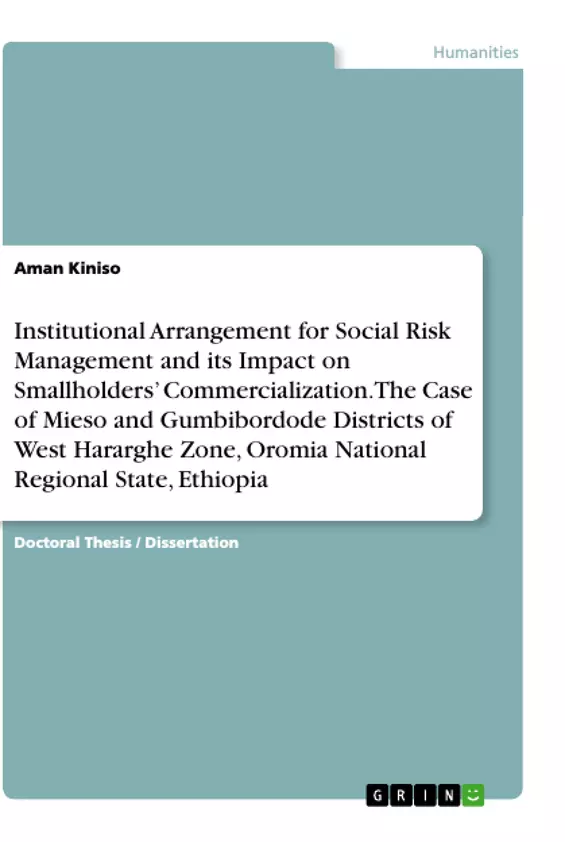The major interest of this study was to identify institutional challenges in smallholders’ commercialization, to assess perceived sources of social risks, to analyze factors affecting the choice of institutional arrangements for social risk management; and to evaluate the impact of institutional arrangements on social risk management on smallholder’s commercialization the case of Mieso and Gumbi-Bordode districts of West Hararghe zone of Oromia Regional State. To meet these objectives a total of 382 sampled households were randomly selected from ten kebeles. Descriptive and inferential statistics of principal component analysis, multivariate regression, and propensity score matching (PSM) were employed to achieve these objectives.
Social risks are a global phenomenon, having severe and direct implications for society, incurring large-scale influence, depending on the cultural, political, and economic context in which this phenomenon manifests itself. In recent years, a more holistic approach and society-wide arrangements of social risk management that go beyond social protection have become increasingly important to assist individuals and households to better manage multiple social risk factors. Given this, in the West Hararghe zone, pastoralists and agropastoralists often deal with social risks through the market, informal and public arrangements in the case of risks due to different reasons. However, the impact of the institutional arrangements for social risk management has not been well studied and documented.
Inhaltsverzeichnis (Table of Contents)
- ABSTRACT
- ACKNOWLEDGEMENT
- DEDICATION
- LIST OF TABLES
- LIST OF FIGURES
- LIST OF ABBREVIATIONS
- CHAPTER ONE: INTRODUCTION
- 1.1 Background of the Study
- 1.2 Statement of the Problem
- 1.3 Objectives of the Study
- 1.3.1 General Objective
- 1.3.2 Specific Objectives
- 1.4 Research Questions
- 1.5 Significance of the Study
- 1.6 Scope of the Study
- 1.7 Organization of the Study
- CHAPTER TWO: LITERATURE REVIEW
- 2.1 Conceptual Framework
- 2.2 The Concept of Institutional Arrangement
- 2.3 Social Risk Management
- 2.4 Smallholders’ Commercialization
- 2.5 Determinants of Smallholders’ Commercialization
- 2.6 The Impact of Institutional Arrangement for Social Risk Management on Smallholders’ Commercialization
- 2.7 Literature Gap
- CHAPTER THREE: RESEARCH METHODOLOGY
- 3.1 Study Area
- 3.2 Research Design
- 3.3 Population and Sampling Techniques
- 3.4 Data Collection Methods
- 3.5 Data Analysis Techniques
- CHAPTER FOUR: RESULTS AND DISCUSSION
- 4.1 Socioeconomic Characteristics of the Respondents
- 4.2 Institutional Arrangement for Social Risk Management
- 4.2.1 Institutional Arrangement for Social Risk Management in Mieso District
- 4.2.2 Institutional Arrangement for Social Risk Management in Gumbi-Bordode District
- 4.3 The Impact of Institutional Arrangement for Social Risk Management on Smallholders’ Commercialization
- 4.3.1 Impact of Institutional Arrangement for Social Risk Management on Smallholders’ Commercialization in Mieso District
- 4.3.2 Impact of Institutional Arrangement for Social Risk Management on Smallholders’ Commercialization in Gumbi-Bordode District
- CHAPTER FIVE: CONCLUSIONS AND RECOMMENDATIONS
- 5.1 Conclusions
- 5.2 Recommendations
- REFERENCES
- APPENDICES
Zielsetzung und Themenschwerpunkte (Objectives and Key Themes)
This dissertation aims to investigate the impact of institutional arrangements for social risk management on the commercialization of smallholder farmers in Ethiopia. Specifically, the study focuses on the districts of Mieso and Gumbi-Bordode in the West Hararghe Zone of Oromia National Regional State.
- Institutional arrangements for social risk management
- The commercialization of smallholder farmers
- The impact of social risk management on smallholder commercialization
- Case study approach to understand the context in Ethiopia
- Analysis of the specific districts of Mieso and Gumbi-Bordode
Zusammenfassung der Kapitel (Chapter Summaries)
The dissertation is structured into five chapters, each exploring a different aspect of the research. The first chapter provides an introduction to the topic, outlining the background, problem statement, objectives, significance, and scope of the study. Chapter two delves into the literature review, establishing a conceptual framework and exploring existing research on institutional arrangements for social risk management, smallholder commercialization, and the link between the two.
Chapter three outlines the research methodology, including the study area, research design, population and sampling techniques, data collection methods, and data analysis techniques. Chapter four presents the results and discussion, examining the socioeconomic characteristics of the respondents, the institutional arrangements for social risk management in both Mieso and Gumbi-Bordode districts, and the impact of these arrangements on smallholder commercialization in each district.
Schlüsselwörter (Keywords)
The central focus of this dissertation revolves around the concepts of institutional arrangements, social risk management, and their influence on smallholder commercialization within the Ethiopian context. Specific keywords include: institutional arrangement, social risk management, smallholder commercialization, agricultural development, rural institutions, and the Ethiopian agricultural sector.
- Quote paper
- Aman Kiniso (Author), 2020, Institutional Arrangement for Social Risk Management and its Impact on Smallholders’ Commercialization. The Case of Mieso and Gumbibordode Districts of West Hararghe Zone, Oromia National Regional State, Ethiopia, Munich, GRIN Verlag, https://www.grin.com/document/1165157



